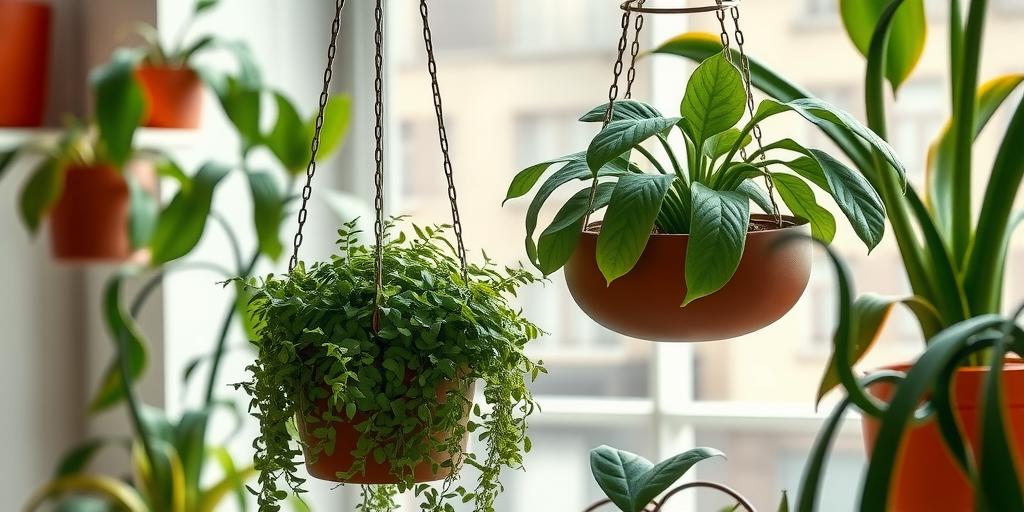
Top Low Light Hanging Plants Safe for Pets and Kids (2025)
Looking for pet- and kid-safe hanging plants that thrive in low light? Discover the best non-toxic, low-maintenance options to brighten up your home without the worry!
Introduction
Did you know that 30% of houseplants are toxic to pets? If you’re a plant lover with kids or furry friends, finding safe, low-light hanging plants can be tricky. But don’t worry—we’ve got you covered! Whether your home lacks sunlight or you just want lush greenery without the hassle, these pet- and kid-friendly hanging plants are perfect for any space. Let’s dive into the best options that are beautiful, easy to care for, and completely safe!
Why Choose Low Light Hanging Plants Safe for Pets and Kids?
Safety First: Avoid Toxic Plants
When you have pets or kids at home, safety is a top priority. Many common houseplants, like Pothos or Philodendron, contain toxins that can cause irritation, vomiting, or worse if ingested. Opting for pet- and kid-safe plants ensures that even if little hands or paws get curious, there’s no risk of poisoning. Always double-check a plant’s toxicity before bringing it home—resources like the ASPCA’s list of non-toxic plants can be a lifesaver.
Low Maintenance for Busy Households
Not everyone has the time to fuss over high-maintenance plants that need constant sunlight or frequent watering. Low-light hanging plants are ideal for busy families because they thrive in indirect light and don’t require daily attention. Many of them can go a week or more between waterings, making them perfect for those who might forget to tend to them regularly.
Space-Saving Greenery
Floor space can be precious, especially in smaller homes or apartments. Hanging plants solve this problem by adding lush greenery without taking up any room on tables or shelves. Whether you hang them in a corner, near a window, or even in the bathroom, they bring life to unused vertical space.
Air-Purifying Benefits
Many pet-safe hanging plants also help improve indoor air quality. Spider plants, for example, are known to filter out common household toxins like formaldehyde and xylene. Boston ferns act as natural humidifiers, which can be especially helpful in dry climates. So, not only do these plants look great, but they also contribute to a healthier home environment.
Best Pet- and Kid-Safe Low Light Hanging Plants
Spider Plant (Chlorophytum comosum)
Spider plants are a classic choice for pet owners and parents alike. They’re completely non-toxic, thrive in indirect light, and are incredibly resilient—perfect for beginners. Plus, they produce “pups” (baby spider plants) that you can easily propagate and share. Their long, arching leaves add a graceful touch to any room.
Boston Fern (Nephrolepis exaltata)
If you love a lush, full look, the Boston fern is an excellent pick. Safe for pets and kids, this fern thrives in humid environments, making it great for bathrooms or kitchens. Just keep the soil consistently moist (but not soggy) and mist the leaves occasionally to maintain humidity.
Peperomia (Peperomia spp.)
Peperomias come in many varieties, from the watermelon peperomia to the trailing ruby cascade. They’re compact, non-toxic, and thrive in low to medium light. Their thick leaves store water, so they’re forgiving if you forget to water them now and then.
Parlor Palm (Chamaedorea elegans)
The parlor palm is a slow-growing, pet-friendly plant that does well in low light. Its feathery fronds add a tropical feel to any space, and it’s one of the easiest palms to care for indoors. Just keep it away from direct sunlight, which can scorch its leaves.
String of Hearts (Ceropegia woodii)
For something a little more unique, the string of hearts is a stunning trailing plant with delicate heart-shaped leaves. It’s safe for pets, drought-tolerant, and thrives in bright, indirect light (though it can handle lower light too). Its long vines make it perfect for hanging baskets where they can cascade beautifully.
Care Tips for Low Light Hanging Plants
Watering: Less Is Often More
One of the biggest mistakes with low-light plants is overwatering. Since they receive less light, they dry out more slowly. Always check the soil before watering—stick your finger about an inch deep. If it’s dry, it’s time to water; if not, wait a few more days. Most of these plants prefer slightly dry soil over being waterlogged.
Placement: Filtered Light Is Key
While these plants tolerate low light, they still need some indirect sunlight to thrive. A north-facing window is ideal, or a spot a few feet away from an east- or west-facing window. Avoid placing them in complete darkness, as even low-light plants need some ambient light to photosynthesize.
Pruning: Keep Them Looking Their Best
Regularly trim yellow or dead leaves to encourage new growth and prevent disease. For trailing plants like the string of hearts, occasional pruning can help maintain a fuller appearance. Use clean scissors to avoid spreading any potential pests or diseases.
Fertilizing: A Little Goes a Long Way
Low-light plants grow slower, so they don’t need frequent fertilizing. A diluted, balanced houseplant fertilizer every 2-3 months during the growing season (spring and summer) is usually enough. Avoid fertilizing in winter when growth naturally slows down.
Common Mistakes to Avoid
Choosing Toxic Plants
It’s easy to fall in love with a plant’s appearance without realizing it’s harmful to pets or kids. Always research before buying—some popular hanging plants like English ivy or certain types of philodendrons can be dangerous if ingested. Stick to verified non-toxic options to keep everyone safe.
Overwatering or Underwatering
Both can be deadly. Overwatering leads to root rot, while underwatering causes dehydration. The key is consistency—check the soil regularly and adjust your watering schedule based on the plant’s needs and the season (plants usually need less water in winter).
Ignoring Pests
Even low-maintenance plants can attract pests like spider mites or mealybugs. Inspect leaves regularly, especially the undersides, where pests like to hide. If you spot any, treat them early with insecticidal soap or neem oil.
Placing in Complete Darkness
While these plants tolerate low light, they still need some indirect sunlight to survive. A completely dark corner will lead to weak, leggy growth or eventual decline. If natural light is scarce, consider supplementing with a grow light to keep them healthy.
By choosing the right plants and following these care tips, you can enjoy beautiful, safe greenery in your home without the stress. Happy planting!
Conclusion
Finding the perfect low light hanging plants safe for pets and kids doesn’t have to be hard! With options like Spider Plants, Boston Ferns, and Peperomias, you can enjoy lush greenery without worry. Remember to follow care tips and avoid common mistakes to keep your plants thriving. Ready to transform your space? Pick your favorite from our list and start hanging!
